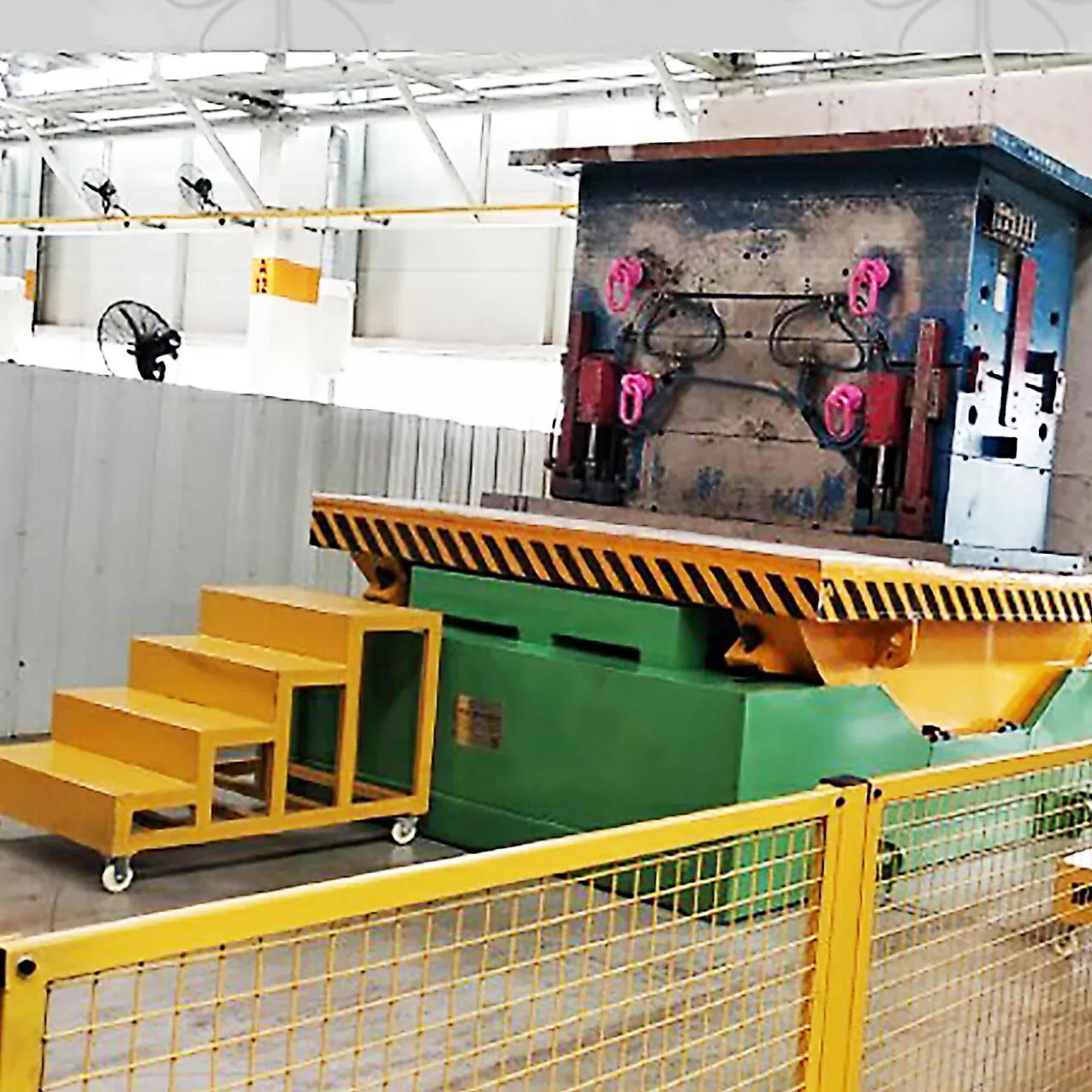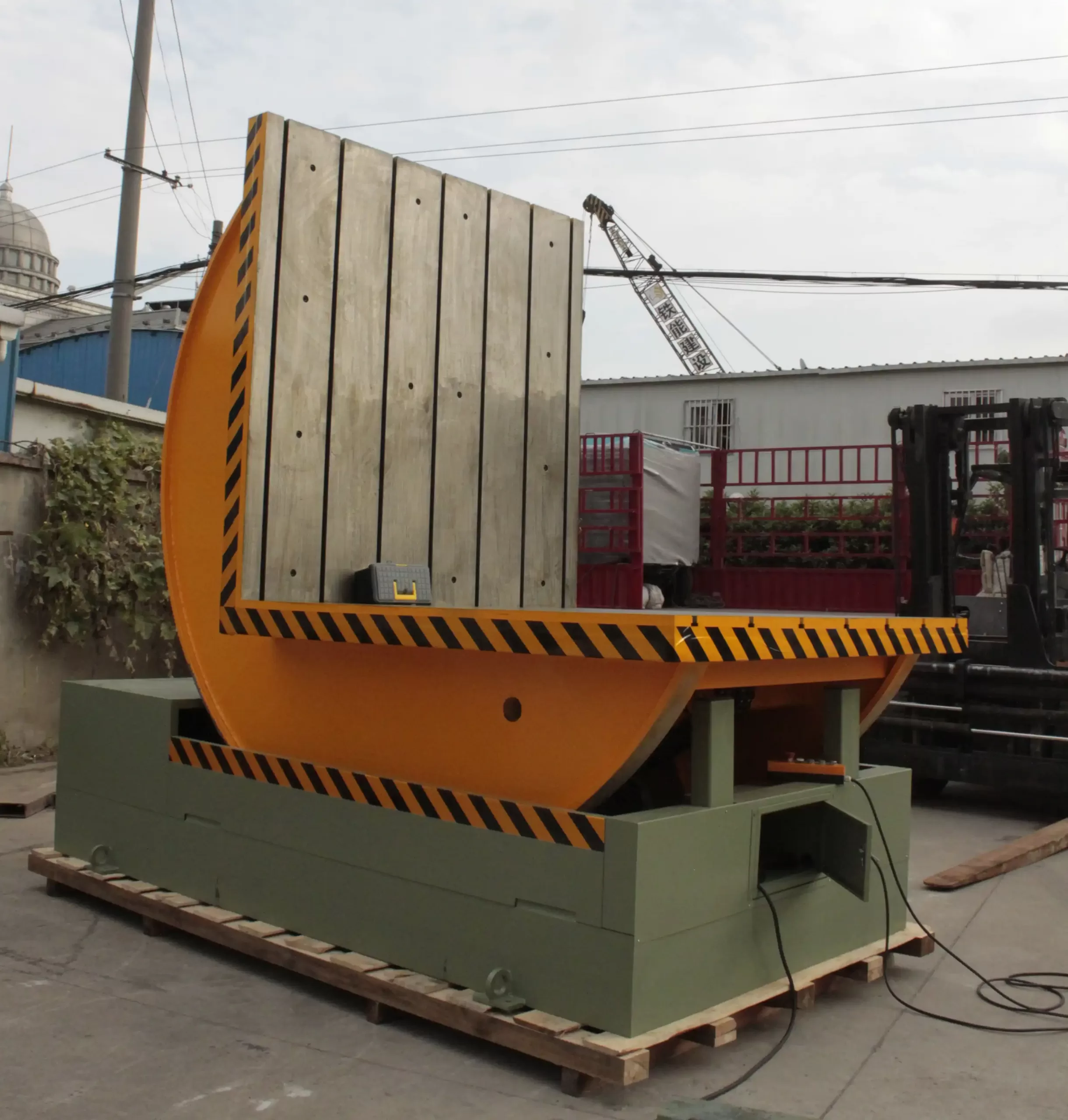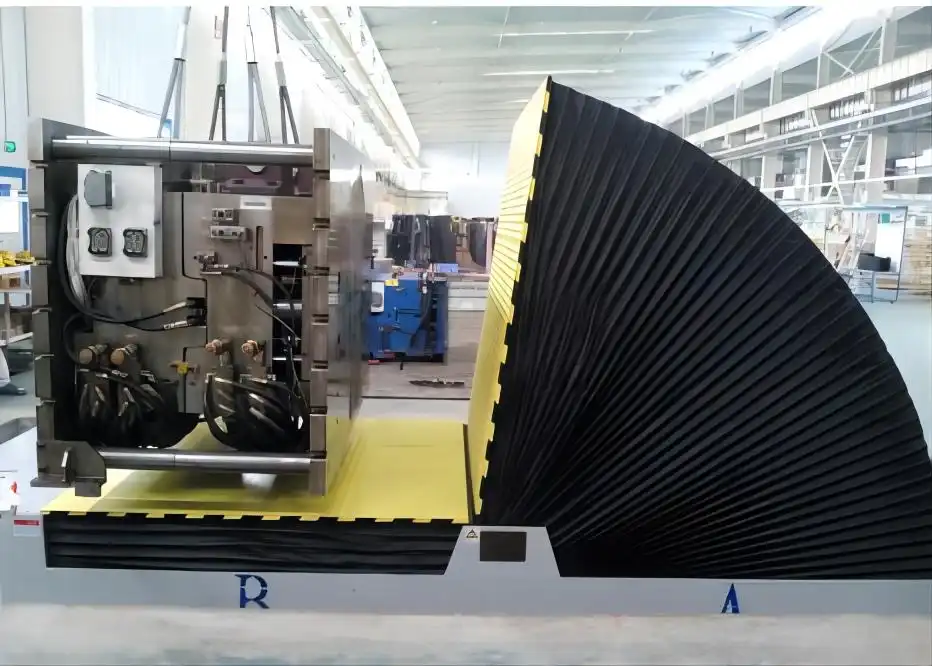What Mold Flipping System Works Best for High-Tonnage Applications in U.S. Plants?
Handling multi-ton molds in a busy U.S. plant presents a daily challenge. You have massive, expensive tools that are essential for production, but moving and repositioning them for maintenance or changeovers is slow and risky. Using overhead cranes with chains and straps is a common practice, but it's a method filled with potential for disaster. A single miscalculation can lead to a damaged mold, costing millions in repairs and lost production, or worse, a catastrophic safety failure. This constant pressure to maintain uptime while ensuring worker safety can feel like an impossible balancing act. The truth is, relying on these outdated methods is no longer a sustainable strategy for a modern, competitive manufacturing plant.
For high-tonnage applications in U.S. plants, the best mold flipping system is a custom-engineered, heavy-duty mechanical mold upender. While hydraulic systems offer smooth control, mechanical systems provide superior long-term reliability, lower maintenance costs, and inherent safety features that are critical for handling heavy, valuable assets. A mechanical design, driven by robust motors and gearboxes, eliminates the risks of hydraulic fluid leaks and the associated maintenance burdens, making it the most practical and cost-effective solution for ensuring both safety and operational efficiency in demanding industrial environments.

I’ve spent my entire career on the factory floor, first as an engineer and now as a factory owner. I’ve seen firsthand what works and what doesn't. When I talk to plant owners like you, who are responsible for multi-million dollar operations, the conversation always comes back to a few key questions. It’s not just about buying a machine; it's about making a strategic investment that pays dividends for years to come. Let's walk through the critical factors you need to consider to make the right choice for your facility.
How Do Mechanical Mold Flippers Handle Safety in High-Tonnage Operations?
Safety is the number one priority on any plant floor, but it becomes a point of extreme focus when you're moving objects that weigh as much as a house. The traditional method of using two overhead cranes to flip a large mold is an activity that makes every safety manager nervous. The process is complex, requires perfect coordination, and leaves zero room for error. A slight imbalance or a slipping chain can have devastating consequences. You are constantly worried about your equipment, but more importantly, about your people. This is a high-stakes operation that modern plants can no longer afford to risk.
Mechanical mold flippers are designed from the ground up to ensure safety in high-tonnage operations by creating a controlled, stable environment. They secure the mold to a heavy-duty platform and use a powerful, predictable drive system to perform the turn. This process is reinforced with multiple redundant safety features, such as electromechanical locking systems, limit switches that prevent over-rotation, and physical hard stops. This eliminates the dynamic and unpredictable swinging forces associated with crane-based methods, transforming a hazardous task into a routine, push-button operation.

A Deeper Look at Safety by Design
When I was a young engineer, I witnessed a near-miss that I’ll never forget. A crew was flipping a large stamping die using two cranes. One of the chains slipped slightly, causing the entire die to lurch violently. Everyone froze. Thankfully, it held, but the incident shut down that bay for hours while a full safety review was conducted. That moment showed me the inherent flaws in relying on manual skill for such a critical task. Modern mechanical mold flippers remove that element of chance.
Built-in Redundancy and Failsafe Mechanisms
The core of a mechanical flipper's safety is its engineering. It’s not just about being strong enough; it’s about having layers of protection.
- Drive System: A worm gear drive, for example, is inherently self-locking. If power is cut for any reason, the gearbox will not allow the load to "free-wheel" or reverse. It simply stops in place.
- Braking Systems: In addition to the self-locking nature of the gearbox, industrial-grade motor brakes are standard. These engage automatically the instant power is lost, providing a second layer of security.
- Limit Switches: These are physical switches that tell the controller when the machine has reached its fully horizontal or vertical position, preventing over-travel that could stress the machine or the mold.
- Physical End Stops: As a final, brute-force failsafe, heavy steel blocks are welded into the frame to physically prevent the machine from ever rotating beyond its designed limits, even if all electronic controls were to fail.
Comparing Safety Risks: The Old Way vs. The New Way
To truly understand the value, it helps to compare the processes side-by-side. The differences are stark and directly impact operational risk and insurance considerations, which are major concerns for any U.S. plant.
| Feature | Crane & Chain Method (Old Way) | Mechanical Mold Flipper (New Way) |
|---|---|---|
| Load Stability | Dynamic and unstable; relies on chain tension and balance | Static and stable; mold is bolted or clamped to a platform |
| Center of Gravity | Constantly shifting and difficult to control | Controlled and predictable throughout the entire rotation |
| Failure Points | Multiple: chains, hooks, slings, crane coordination | Fewer and more robust: gearbox, motor, frame structure |
| Human Error | High potential; relies on operator skill and coordination | Low potential; push-button operation with interlocks |
| OSHA Compliance | Complex; requires extensive rigging plans and training | Simplified; machine is a self-contained, guarded system |
| Personnel Proximity | Workers often need to be close to guide the load | Operator is at a safe distance at a control console |
By investing in a purpose-built mechanical mold flipper, you are not just buying a piece of equipment. You are implementing an engineered safety control that removes one of the most hazardous operations from your plant floor.
What are the ROI and Maintenance Implications of Hydraulic vs. Mechanical Systems?
As a business owner, every major capital expenditure comes down to the numbers. You're looking at a new piece of equipment, and your first thought isn't just "How much does it cost?" but "What is the total cost of ownership?" You've been burned before by machines that had a low sticker price but ended up costing a fortune in downtime and maintenance. The prospect of dealing with constant hydraulic leaks, filter changes, and specialized fluid disposal is a major concern. You need a system that is not only effective but also predictable and cost-efficient over its entire lifespan.
For high-tonnage applications, mechanical mold flippers almost always deliver a stronger Return on Investment (ROI) due to their significantly lower maintenance requirements. The TCO (Total Cost of Ownership) of a mechanical system is more predictable because it avoids the recurring costs associated with hydraulics, such as fluid replacement, hose failures, and environmental compliance. While a hydraulic system might offer nuanced speed control, the long-term reliability and reduced downtime of a simpler, more robust mechanical system translate directly to a healthier bottom line.

Breaking Down the Total Cost of Ownership (TCO)
I helped a client once who ran a large tool and die shop. They had an older hydraulic upender for their molds. The plant manager told me they were spending nearly $10,000 a year just on hydraulic fluid, filters, and cleanup materials for the inevitable leaks, not to mention the maintenance technician's time. When we calculated the cost of downtime—one unexpected leak could halt their mold-prep area for half a day—the numbers became staggering. We replaced it with a heavy-duty mechanical system. A year later, he called me just to say their only maintenance cost had been a canister of grease for the main bearings. That's a real-world example of TCO in action.
Head-to-Head Maintenance Comparison
The maintenance schedules for mechanical and hydraulic systems are fundamentally different. One is proactive and minimal; the other is reactive and constant.
| Maintenance Task | Mechanical System | Hydraulic System |
|---|---|---|
| Daily Checks | Visual inspection of components | Check for fluid leaks, inspect hoses for wear/cracks |
| Weekly Checks | N/A | Check hydraulic fluid level and clarity |
| Monthly Checks | Grease key bearings and fittings | Check pump pressure, test relief valves |
| Annual Checks | Inspect gearbox oil, check bolt torque | Change hydraulic fluid, replace filters, pressure test hoses |
| Common Failures | Predictable wear on bearings or gears (long life) | Unpredictable hose bursts, cylinder seal failures, pump burnout |
| Environmental Impact | Minimal (small amount of gear oil) | Significant (potential for large fluid spills, fluid disposal costs) |
The Uptime Equation: Reliability is Profitability
In a high-production U.S. plant, uptime is everything. A mold flipping system isn't a primary production machine, but it is a critical bottleneck. If it goes down, mold changes stop, and soon after, your production lines will starve.
- Mechanical Reliability: The failure modes in a mechanical system are typically slow and predictable. A bearing might start to make noise long before it fails. A gear will show wear patterns during inspection. This allows for scheduled, proactive maintenance during planned downtime. The system is fundamentally simpler with fewer components to fail.
- Hydraulic Unreliability: Hydraulic systems are prone to sudden, catastrophic failures. A hose bursting under thousands of PSI of pressure doesn't give you a warning. It instantly incapacitates the machine and creates a safety and environmental hazard. These unpredictable failures are what kill production schedules and drive up operational costs.
When you choose a mechanical system, you are investing in predictability. You are choosing a machine that works quietly in the background, demands little attention, and won't give you a costly surprise on a Tuesday morning. That reliability is a cornerstone of a positive ROI.
How Can Automation in Mold Flipping Systems Address Labor Shortages in U.S. Plants?
Finding and retaining skilled labor is one of the biggest challenges facing U.S. manufacturing today. You need your most experienced people—your riggers, your crane operators, your senior maintenance crew—focused on high-value tasks that require their expertise. Instead, they are often tied up in logistical, non-value-added activities like flipping a mold. This process can take two or three skilled workers a significant amount of time, pulling them away from more critical duties. It's an inefficient use of your most valuable resource: your people.
Automated mold flipping systems directly combat labor shortages by transforming a labor-intensive, multi-person task into a simple, one-person operation. By automating the entire flipping cycle, the system allows a single operator to manage the process from a safe, remote console. This frees up other skilled workers to focus on tasks like mold preparation, machine setup, or preventative maintenance, dramatically increasing the overall labor efficiency and productivity of your entire plant.

From Manual Effort to System Oversight
Think about the traditional process. A crane operator is in the cab, focused on the controls. At least one, and often two, riggers are on the floor, attaching heavy chains, guiding the load, and communicating with the operator via hand signals. It's a slow, deliberate dance that requires constant focus from everyone involved. The entire operation can easily take 30 to 45 minutes from start to finish.
Now, picture an automated system. The forklift operator places the mold onto the flipper's platform. An operator walks to a control panel, selects the pre-programmed cycle, and pushes a button. The machine automatically clamps the mold, performs the 90-degree or 180-degree turn, and unclamps. The entire process takes less than 5 minutes. The same forklift operator can then pick up the reoriented mold and move it to its next destination. The crane operator and riggers were never involved; they are already working on the next job. This isn't a small improvement; it's a fundamental change in workflow.
Integration with the Smart Factory Ecosystem
For forward-thinking leaders like Javier, the goal is a fully connected, digital factory. An automated mold flipper is a perfect component for this vision. It's not just a standalone machine; it's a node in your plant's information network.
- MES Integration: The mold flipper can be connected to your Manufacturing Execution System (MES). The MES can schedule a mold flip, send the command directly to the machine's PLC, and the flipper can report back when the task is complete. This removes manual scheduling and tracking.
- AGV/Rail Cart Compatibility: In a fully automated plant, an Automated Guided Vehicle (AGV) or rail-guided cart can deliver the mold to the flipper. Sensors confirm the mold is in position, the flipper performs its cycle, and then signals the AGV to retrieve the mold. This creates a "lights-out" mold handling process with zero direct labor.
- Data for Predictive Maintenance: The system's PLC and sensors track motor amperage, cycle times, and fault codes. This data can be fed into a plant-wide analytics platform to predict maintenance needs, further enhancing uptime and reducing reliance on manual inspections.
This level of automation directly addresses the labor challenge by multiplying the effectiveness of your existing team. You don't need to find three people for a mold flip; you need one person to oversee an automated system that does the work of three. That's how you win in a tight labor market.
Why is Customization Key for Integrating a New Mold Flipper into an Existing U.S. Production Line?
No two manufacturing plants are exactly alike. Your facility has a unique layout, a specific workflow, and equipment that has been in place for years. You can't just drop a standard, "one-size-fits-all" machine onto your floor and expect it to work seamlessly. A machine that is too large might not fit in the available space. A platform that is the wrong size or shape won't securely hold your specific molds. A control system that can't talk to your other equipment is an operational dead end. This is a common frustration I hear from plant managers who bought an off-the-shelf solution only to spend months and thousands of dollars trying to make it fit.
Customization is the only way to guarantee that a new mold flipper will integrate perfectly into your existing U.S. production line. A custom-engineered solution is designed around your specific requirements—from the exact dimensions and weight of your molds to your plant's floor space, power supply, and workflow. This tailored approach ensures the machine is not just a functional piece of equipment, but a natural and efficient extension of your current operations from day one, eliminating the costly and time-consuming problems associated with forced integration.

The Customization Checklist: What Matters Most
When we start a project with a new client, we don't begin by showing them a catalog. We start by asking questions and listening. We act as partners, not just suppliers. This process is about building the right machine, not just a machine. Here are the key parameters we always define.
| Customization Parameter | Why It's Critical for Your Plant |
|---|---|
| Load Capacity & Center of Gravity | Must safely handle your heaviest and most unbalanced molds without stress. Off-the-shelf units often have generic ratings. |
| Platform Size & Shape | The table must match the footprint of your molds for secure clamping and support. We can add custom V-blocks, locating pins, or surfaces. |
| Footprint & Machine Profile | The machine must fit within your available floor space and below any overhead obstructions like cranes or building structures. |
| Rotation Degree & Speed | Do you need a 90° flip for inspection or a 180° turn for mold-half separation? We can tailor the speed to protect sensitive molds. |
| Loading/Unloading Method | Will you use a forklift, overhead crane, or AGV? The machine's design must allow clear and safe access for your specific method. |
| Control System & Integration | The controls must be intuitive for your operators and have the ability to connect with your plant's MES or other automation systems. |
From Brownfield to Perfect Fit: A Personal Story
I remember working with a steel stamping plant in the Midwest. It was a classic "brownfield" site—an older building that had been expanded and modified over decades. They needed a 50-ton mold flipper, but the only available space was in a tight corner with a low ceiling and uneven floors. No standard machine would work.
Our team went to the site. We took laser measurements of the area. We analyzed their mold drawings. We talked to their forklift drivers and maintenance crew to understand the workflow. Based on this, we designed a low-profile mechanical flipper with a custom-sized platform. We even designed the base to accommodate the uneven floor. The motor and gearbox were repositioned to one side to fit the tight footprint. When we installed it, it fit like a glove. The plant manager said it looked like it had been part of the original building design. That's the power of customization. It solves problems before they happen and turns a potential headache into a powerful asset.
Conclusion
Choosing the right mold flipper is a strategic decision. Focus on safety, total cost of ownership, and custom integration to ensure long-term success for your high-tonnage U.S. plant.





